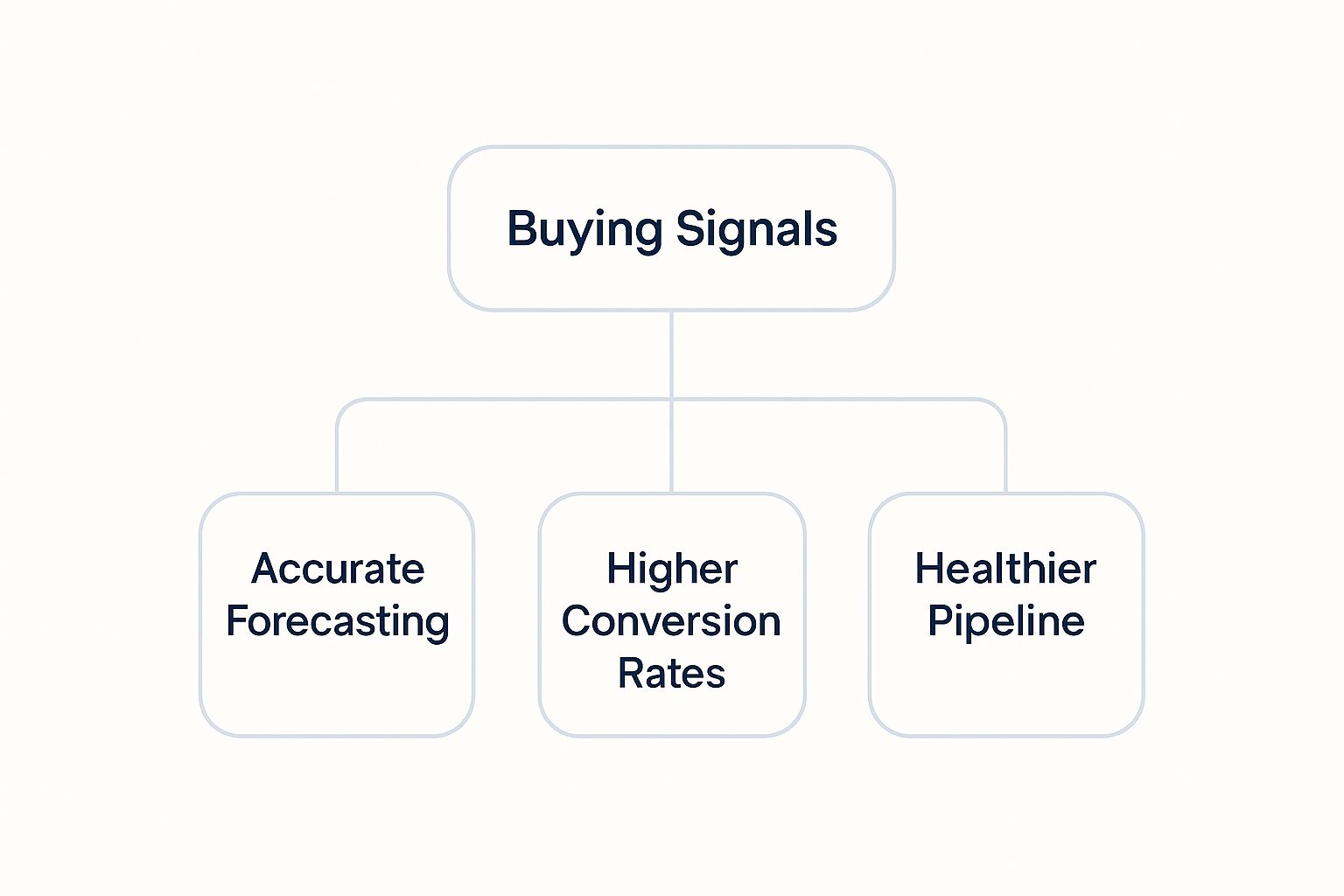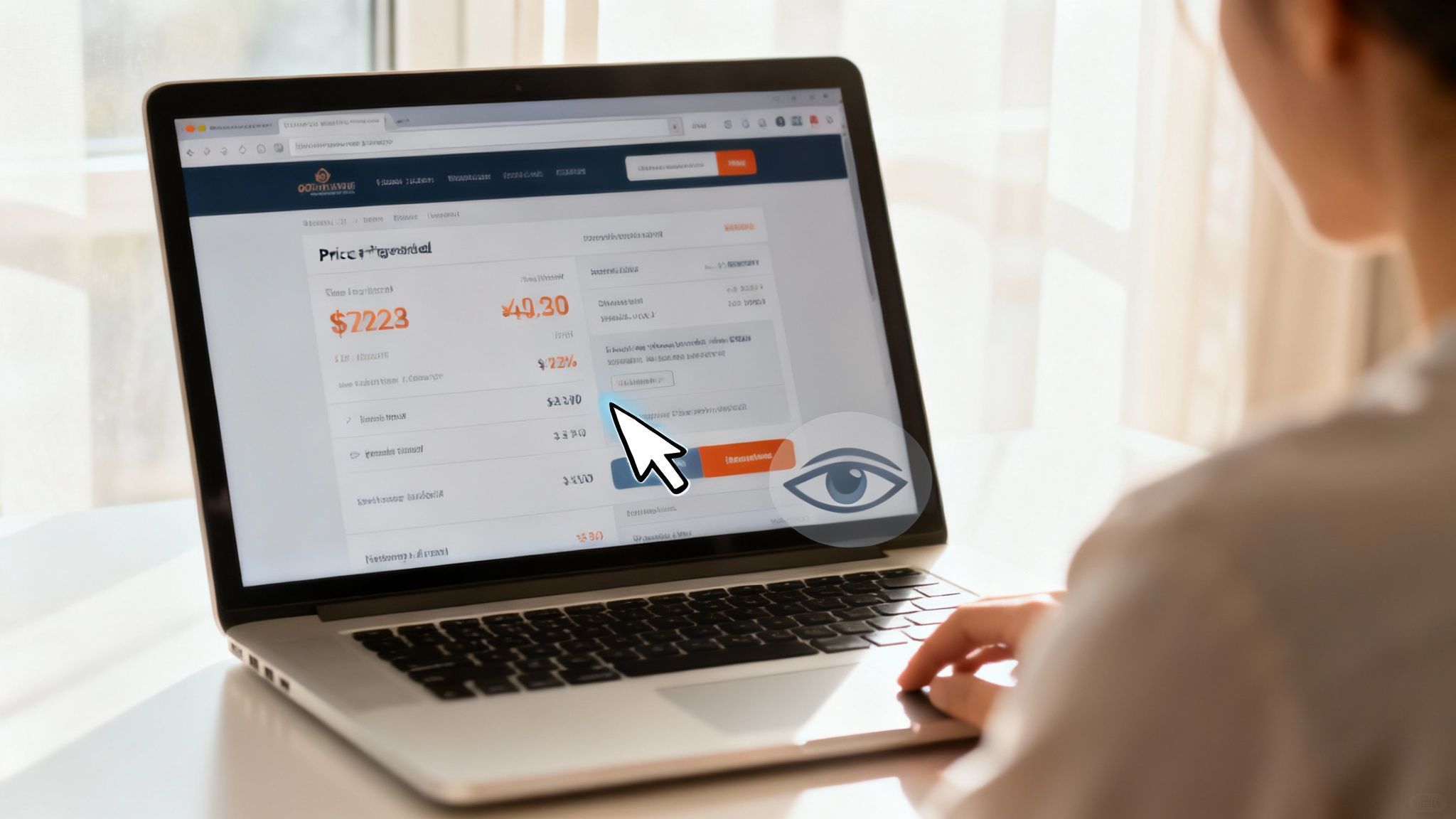What Is a Buying Signal in Sales and How to Spot It
Discover what is a buying signal in sales with our guide. Learn to spot verbal and digital cues to qualify leads and close deals faster.
Discover what is a buying signal and learn how to recognize verbal and digital cues in B2B sales to close deals faster and boost your pipeline.
TL;DR: A buying signal is a clear action or question from a prospect indicating they're ready to purchase. Spotting these cues—like questions about pricing or repeat visits to your demo page—helps you focus on deals that will actually close, turning guesswork into a smarter, faster sales process.
In sales, timing is everything. A buying signal is an action, a question, or a subtle comment from a prospect that tells you they're getting serious about a purchase.
It's the green light you've been waiting for. These cues are your signal to shift gears and move the conversation toward a decision. Learning to spot them is what separates the pros from the amateurs, helping you focus on the deals that are actually ready to close.

In a packed sales environment, your time is your most valuable asset. The goal is to spend that time on prospects who are genuinely interested and heading toward a purchase, not on those who are just kicking tires.
This is where spotting buying signals becomes a superpower for any sales professional.
These signals are your prospect's way of telling you they’ve mentally moved from asking "if" they should buy to "how" they will buy. Getting good at picking up on these verbal and digital cues means you can:
Ultimately, these signals are the roadmap you need to navigate the sales process with precision. They turn passive interest into an active pipeline, and they're the difference between guessing where you stand and knowing it's time to make your move.
Spotting a buying signal isn't just a clever sales tactic; it's a core strategy for selling efficiently. Think of these cues as your roadmap in the sales process. They point you straight to the prospects who are genuinely engaged and moving toward a purchase.
When you learn to read these signals, you're no longer just guessing. You're operating with a data-informed strategy. Your sales team can stop casting a wide net and start crafting pitches with surgical precision. This lets you get ahead of unspoken concerns and time your closing conversations for maximum impact.
Focusing on prospects who send clear signals changes your entire sales motion. It directly boosts your most important metrics by ensuring your team spends time where it really counts. This strategic focus is what turns a good sales team into a great one.
The infographic below breaks down how buying signals lead to better sales outcomes.

As you can see, mastering signal detection is the first step toward more accurate forecasting, higher conversion rates, and a healthier, predictable pipeline.
This idea is a cornerstone of a bigger strategy called signal-based selling. It’s a modern approach that ditches old-school, volume-based outreach in favor of data-driven engagement. You can dive deeper into how to implement signal-based selling in our detailed guide.
By homing in on these cues, you eliminate wasted effort on stalled deals and concentrate your energy on opportunities with the highest probability of closing. It’s about working smarter, not harder.
The data used to generate these signals has also gotten much more sophisticated. Today, it often includes datasets like insider stock transactions and web traffic data to make buying signals even more accurate. This evolution is what turns your sales pipeline into a well-oiled machine, free of the guesswork that holds teams back.
Some of the most powerful buying signals aren't hidden in data—they're spoken out loud. When a prospect starts asking certain types of questions, they’re giving you a direct invitation to move the deal forward.
Pay close attention. This is the moment a prospect’s mindset shifts from ‘if we should buy’ to ‘how we will buy.’

These verbal cues are your green light. They tell you the buyer has moved beyond simple curiosity and is now mentally road-mapping how your solution fits into their world. Hearing these questions means it's time to guide them across the finish line.
When a prospect starts digging into the details of getting started, they're no longer just evaluating your product—they're visualizing life with it. They are mentally walking through the process of bringing your solution into their daily workflow.
You'll start hearing questions like:
These questions aren't about the what; they're about the how. The prospect is actively trying to build a bridge from their current state to a future state with you in it. To get better at structuring these critical conversations, frameworks like SPIN selling can be incredibly valuable.
This is the most classic buying signal of all. Any question about cost, contracts, or next steps is a huge tell. When a prospect brings up money, it means they're doing the final math, weighing the investment against their budget.
A direct inquiry about pricing or a proposal is one of the highest-intent signals you can receive. On average, only three vendors get a demo or a quote when a purchase decision is being made, so this question often means you’re on the shortlist.
Listen for phrases such as:
When these questions pop up, it’s your cue to advance the sale. They aren't just asking for info; they're asking you to help them justify the purchase and make the final decision.
The types of questions a prospect asks can tell you exactly where they are in their journey. Here’s a quick look at how these verbal cues typically align with the sales funnel.
| Sales Stage | Example Buying Signal (Verbal Cue) | What It Indicates |
|---|---|---|
| Consideration | "How does your solution compare to [Competitor]?" | They've done their homework and are actively comparing options. |
| Evaluation | "Could we set up a trial or proof of concept for our team?" | They want to validate the solution's fit within their specific environment. |
| Justification | "Can you provide a business case or ROI data?" | They need to sell the purchase internally to stakeholders. |
| Negotiation | "What kind of flexibility is there on the payment terms?" | They've decided to move forward and are now focused on the final details. |
| Closing | "Who would be our main point of contact after we sign?" | They are mentally preparing for the post-purchase relationship. |
Recognizing these questions for what they are—clear signals of intent—allows you to respond appropriately and keep the momentum going. Instead of just answering the question, you can pivot the conversation toward the next logical step in their buying process.
In sales, we're taught to listen closely to what a prospect says. But what they do online often tells a much richer story. This "digital body language" is the stream of clicks, downloads, and page visits that reveal genuine interest long before anyone picks up the phone.
These actions are often more honest than spoken words. They're the leading indicators that an account is heating up. A contact repeatedly visiting your pricing page isn't just window shopping; they're moving from casual research into serious evaluation.

Learning to read this behavior is like gaining a superpower. It lets you engage prospects at the perfect moment, armed with context that makes your outreach immediately relevant.
Your website, content, and webinars are all listening posts. Every interaction is a breadcrumb, a piece of a story about your prospect's priorities and urgency.
So, what are the key actions to monitor?
These digital footprints are closely related to another crucial concept: intent data. To get a fuller picture of how these signals fit into a broader strategy, it's helpful to understand the role of intent data in sales.
Just like in financial markets, where strong early-year performance can be a buying signal for investors, a sudden surge in digital engagement from a target account signals that a deal might be heating up.
This isn't just an analogy; a pattern of positive activity often precedes a major move. It’s a universal principle of paying attention to leading indicators.
Tracking these signals is step one. The real magic happens when you interpret them correctly and take action. Mastering Account Engagement Best Practices is crucial for turning these online actions into tangible pipeline.
For example, when a prospect downloads a case study about the manufacturing industry, your next outreach can be laser-focused on that exact use case. If they forward a webinar invite to their team, you know the conversation has expanded beyond a single stakeholder.
By decoding this digital body language, you stop being a passive observer and become a proactive partner in their buying journey. That’s how you accelerate the entire sales cycle.
Spotting a buying signal is only half the battle. Your response is what moves the deal forward. Seeing a signal and doing nothing is like getting a green light but staying parked at the intersection. The real magic happens when you turn that observation into proactive, relevant engagement.
Each signal is an opening to advance the conversation. If a prospect downloads a case study, your follow-up shouldn’t be a generic "just checking in" email. It needs to add value based on that specific action.
For example, a strong response would be: "Saw you were interested in our work with [Industry] companies. The key challenge we solved for them was [specific problem], which I imagine resonates. Do you have 15 minutes to discuss how a similar approach might work for your team?"
Not all buying signals are created equal. A visit to your pricing page is a much stronger indicator of intent than a casual social media follow. This is where implementing effective lead scoring best practices helps. It lets your sales team focus their energy on the leads most likely to convert.
Once you know who to talk to, personalization is everything. Your response must be fast and directly tied to the signal you observed.
The goal is to make every interaction feel like a natural continuation of their research, not an interruption. You're helping them on their journey, not just trying to sell them something.
This targeted approach requires deep account knowledge. You have to understand who the key players are, especially the internal champion who can advocate for your solution. For more on this, check out our guide on effective champion tracking.
Think of it like high-frequency trading. A trader sees a signal and executes an immediate trade before the market changes. In sales, the market change is a competitor getting there first. Your speed and relevance are your competitive edge.
The most common and direct buying signals are questions about pricing, contract terms, or implementation. When a prospect asks, "What does pricing look like for a team of 50?" they have mentally moved from evaluating if they should buy to figuring out how to buy.
Respond quickly and with context. Acknowledge their action and use it as a natural reason to continue the conversation. For example, if they download a case study, follow up with, "I saw you downloaded our [X] case study. Happy to share how we achieved similar results for others in your industry." The key is to be helpful, not pushy.
A lead score is a cumulative grade based on a prospect's demographic fit and overall engagement over time (e.g., +5 for a director title, +10 for opening 5 emails). A buying signal is a specific, high-intent action happening right now, like requesting a demo or visiting the pricing page three times in one day. A strong buying signal is often more urgent than a high lead score.
Absolutely. A prospect might download a pricing sheet for competitive research or explore solutions for a project that isn't budgeted yet. A signal is a starting point, not a guaranteed sale. Always pair signal detection with good qualification to confirm their timeline, budget, and authority.
Stop wasting hours on manual research and start acting on real-time intelligence. Salesmotion surfaces buying signals from across the web and delivers them directly to you, so you can focus on what you do best—selling. See how it works at https://salesmotion.io.
Discover what is a buying signal in sales with our guide. Learn to spot verbal and digital cues to qualify leads and close deals faster.
Unlock the power of B2B intent data. Learn how it works, why it matters, and how to use it to identify buyers and close deals before your competitors...
Stop guessing and start selling. This guide to buying signals sales helps you identify critical cues, engage smarter, and accelerate your pipeline.